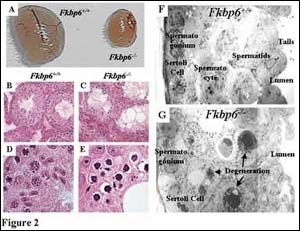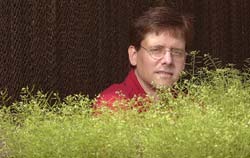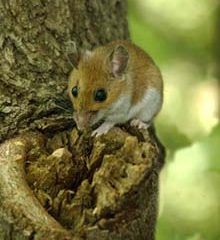Life Sciences and Chemistry
Articles and reports from the Life Sciences and chemistry area deal with applied and basic research into modern biology, chemistry and human medicine.
Valuable information can be found on a range of life sciences fields including bacteriology, biochemistry, bionics, bioinformatics, biophysics, biotechnology, genetics, geobotany, human biology, marine biology, microbiology, molecular biology, cellular biology, zoology, bioinorganic chemistry, microchemistry and environmental chemistry.

Essential gene for male fertility found
Mice without Fkbp6 gene have significantly reduced testes, completely lack sperm cells
A gene that belongs to a family of genes implicated in heart disease has been found to be essential for male fertility but has no impact on female fertility, researchers at U of T, along with colleagues in New York and Japan, have discovered.
“This gene – Fkbp6 – is a member of a family of genes that have been implicated in immunosuppression and heart disease,” says Dr. Josef Penninger, pr

Body clocks keep migrating monarchs on course, Science study shows
Butterfly flight simulator sheds light on epic migration
During their winter migration to Mexico, monarch butterflies depend on an internal clock to help them navigate in relation to the sun, scientists have found.
By studying monarchs inside a specially designed flight simulator, the researchers have gathered what they believe is the first direct evidence of the essential role of the circadian clock in celestial navigation. The study appears in the journal Science, publishe

Gene may produce drought-resistant plants
The identification and duplication of a gene that controls production of plants’ outermost protective coating may allow Purdue University researchers to create crops with increased drought resistance.
Scientists cloned the gene WAX2 after they discovered a fast-wilting mutant of Arabidopsis, a commonly used experimental plant. The gene is directly associated with the synthesis of the protective layer of plants, called the cuticle, and its contained waxes, according to the study publ

Mouse study suggests mammoth evolutionary change
A study of a common wild mouse by two University of Illinois at Chicago biologists has found evidence of dramatic evolutionary change in a span of just 150 years, suggesting genetic evolution can occur a lot faster than many had thought possible.
The findings are the first report of such quick evolution in a mammal and appear in the May 22 issue of the journal Nature.
Oliver Pergams, a conservation biology researcher with the Chicago Zoological Society in Brookfield, Ill. and visiting

Making sense of the genome
Almost every week we hear of a new genome sequence being completed, yet turning sequence information into knowledge about what individual genes do is very difficult. An article published in Journal of Biology this week will simplify this task, as it describes a new online tool that dramatically improves predictions of how individual genes are regulated. Dr. Wyeth Wasserman and his team have created this powerful new two-step method for identifying which regulators of gene expression, called

Birds and humans have similar ’shopping’ habits
Feeding birds display similar habits to human consumers shopping for food, according to research published in the current edition of the Proceedings of the Royal Society.
A two-year study has discovered it is possible to influence hummingbirds’ choice of food by changing the options available to them, in the same way supermarkets can manipulate customers’ preferences by clever positioning of products.
The study is published in the current edition of Proceedings of the Royal Society